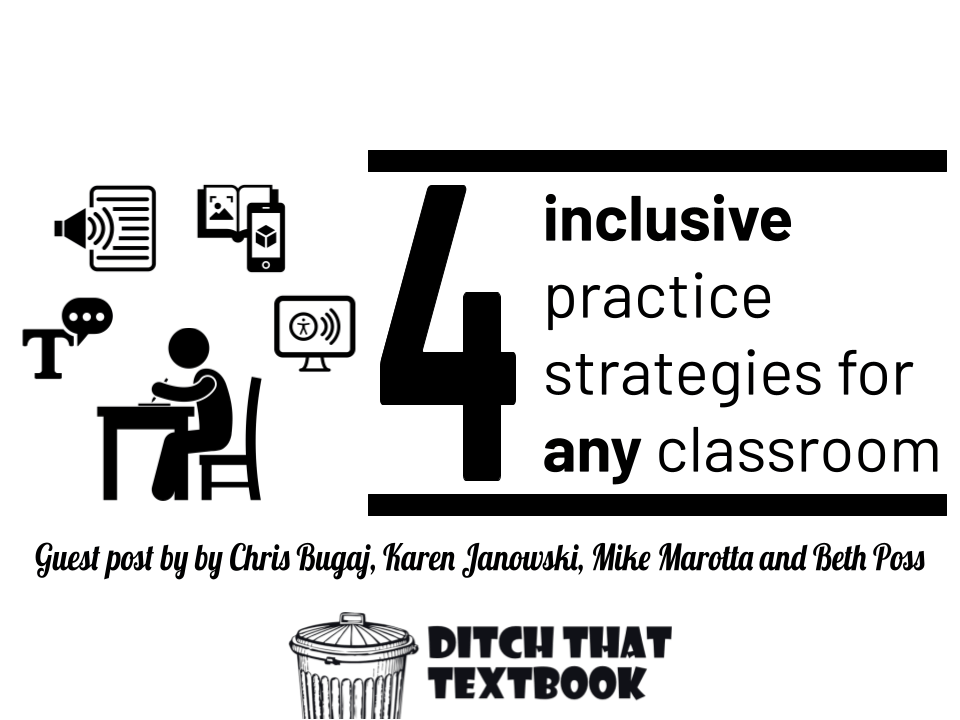
Embrace the inclusive mindset to transform any environment to a place where every learner has the opportunity to be successful. By utilizing technology tools effectively, all educators can promote inclusive learning and all learners can thrive.

This post was written by Chris Bugaj (@attipscast), Karen Janowski (@KarenJan), Mike Marotta (@mmatp) and Beth Poss (@PossBeth) the authors of the book Inclusive Learning 365: Edtech Strategies for Every Day of the Year. To learn more about inclusive strategies and to order your copy of the book, visit inclusive365.com.
“Thank goodness! Now I will never have to read another book!”
Upon graduation, those words came from my (Karen’s) son who has dyslexia. He found reading content extremely challenging throughout school. Instructional methods were not designed to address his unique needs, accept his learning variabilities or build on his many strengths. So he struggled and eventually began to hate reading.
As a teacher, and a parent, this is heartbreaking to hear. However, for many students who struggle with reading, this is their reality for much of their academic career.
So what drives some learners to view their school experience so negatively? And what can we do to change the course before it gets to this point?
Adopting an inclusive mindset
As educators, we know that designing experiences that reach all learners is a fundamental skill. Consequently, adopting an inclusive mindset is necessary before one can design educational experiences that meet every individual's need.
What is an inclusive mindset?
Within an inclusive mindset is the belief that inclusion is feasible, that all learners can achieve their potential, and that we must offer strategies that are flexible, accessible to all and intentionally designed. Inclusive educational experiences rarely happen by accident. Designing for inclusivity acknowledges learner variability and focuses on strengths that promote engagement, success, and autonomy.
Putting an inclusive mindset into practice
Technology can be used to design experiences that are flexible while removing obstacles to independence. In the spirit of building inclusive learning experiences, effective integration of inclusive educational technology helps create barrier free learning spaces where each individual has access to the tools they need to succeed. Ubiquitous technologies remove the learner’s self-perception of being different, and they develop the metacognitive skills to identify what works best depending on the task.
If the principal responsibility of an educator is to support the learners they serve, then every educator should explore these incredible technologies designed with inclusivity and accessibility in mind. Learners can be invited to evaluate the features for themselves, develop their own awareness of what’s available, and develop their own technology toolkit for life-long learning.
4 inclusive practice strategies for anyone
What follows are a series of strategies which serve as examples of inclusive practices adapted from the book, Inclusive Learning 365.
Strategy 3 - Accessibility of Materials
Accessibility means more than just dropping files into your Google Drive. By making your documents digital, you are making them available, not accessible. Accessibility focuses on the usability of a digital file (document, slides, spreadsheets, digital books, websites) that ensures that every learner can use those materials to learn in the way that works best for them.
Some questions educators should ask themselves include:
Can this material be read aloud by a text to speech application?
Can the materials be enlarged or magnified?
Are there captions available for audio components?
Is alt text provided to describe visuals throughout the materials?
Try your built in accessibility features to provide read aloud support for digital text. Are you using a Chromebook? Turn on Select to Speak for text to speech support.
Providing accessible digital text to learners enables them to adjust font size throughout the documents to better support their visual needs.
Whether it is the built in captions available in PowerPoint or Google Slides, or the auto caption feature in Zoom or Google Meet - there are good options for providing this support.
After inserting pictures into your document, right click to choose the Alt+Text option. Add in descriptive text that highlights the important aspects of that image and its relevance to your document.
Strategy 26 - Discovering Hidden Artifacts Using Geocaching and Augmented Reality
Invite learners to use their individual abilities to unravel a mystery to find a hidden treasury by engaging in real world or augmented reality treasure hunting experiences.
Experiences where learners act as hunters of artifacts in either physical or virtual spaces provides an opportunity to unlock a passion for truth seeking, problem solving, and collaboration with others. Waypoint Edu (waypointedu.com) is a tool to explore to help you create an immersive experience is
Strategy 123 - Integrating Scaffolded Supports to Improve Reading Comprehension
Digital text provides the flexibility needed to integrate supports such as including questions, notes, videos and vocabulary definitions. These supports provide scaffolds to improve reading comprehension and engagement with the text.
CommonLit.org is a website that has digital texts with built in supports including annotation tools, text to speech, translation, word definitions, and more. Check out this video of Imogen using scaffolds within Common Lit as supports with her literacy tutor.
Check out the video of Strategy 123 in action! https://youtu.be/ZMyJVRBfk_o
Strategy 131 - Converting Analog Text to Read Alouds on the Fly
Encountering text in the environment occurs throughout our day no matter the location. In school, text is provided in books, worksheets, posters on the wall and notices to share with parents. Beyond the school day, analog text is encountered in signs, menus, directions, magazines and leisure reading. Evolving or multilingual readers may benefit from the option to quickly convert analog text to a digital format and then attach a voice to listen to the audio. Learners now have a strategy that promotes independent access to content, no matter where they are. Microsoft Lens and Seeing AI, two free apps from Microsoft, offer this capability for independence.
For notifications of new Ditch That Textbook content and helpful links:
Are you looking for quality, meaningful professional learning that both equips and inspires teachers?
Matt provides in-person and virtual keynotes, workshops and breakout sessions that equip, inspire and encourage teachers to create change in their classrooms. Teachers leave with loads of resources. They participate. They laugh. They see tech use and teaching in a new light. Click the link below to contact us and learn how you can bring Matt to your school or district!
Is Matt presenting near you soon? Check out his upcoming live events!



Thanks for posting this! Will listen to some of these when I have some free time 🙂